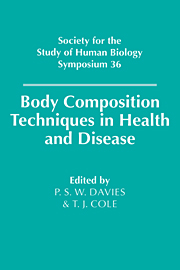Book contents
- Frontmatter
- Contents
- List of contributors
- 1 Application of dual-energy X-ray absorptiometry and related techniques to the assessment of bone and body composition
- 2 In vivo neutron activation analysis: past, present and future
- 3 Magnetic resonance imaging for the assessment of body composition
- 4 Multi-frequency impedance as a measure of body water compartments
- 5 Body composition assessed by electrical conductivity methods
- 6 Body composition in malnutrition
- 7 Influence of body composition on protein and energy requirements: some new insights
- 8 Prediction of adult body composition from infant and child measurements
- 9 Assessment of body composition in the obese
- 10 The role of body physique assessment in sports science
- 11 The assessment of the body composition of populations
- 12 Changes in approach to the measurement of body composition
- 13 Multi-compartment models for the assessment of body composition in health and disease
- 14 The future of body composition research
- Index
13 - Multi-compartment models for the assessment of body composition in health and disease
Published online by Cambridge University Press: 18 September 2009
- Frontmatter
- Contents
- List of contributors
- 1 Application of dual-energy X-ray absorptiometry and related techniques to the assessment of bone and body composition
- 2 In vivo neutron activation analysis: past, present and future
- 3 Magnetic resonance imaging for the assessment of body composition
- 4 Multi-frequency impedance as a measure of body water compartments
- 5 Body composition assessed by electrical conductivity methods
- 6 Body composition in malnutrition
- 7 Influence of body composition on protein and energy requirements: some new insights
- 8 Prediction of adult body composition from infant and child measurements
- 9 Assessment of body composition in the obese
- 10 The role of body physique assessment in sports science
- 11 The assessment of the body composition of populations
- 12 Changes in approach to the measurement of body composition
- 13 Multi-compartment models for the assessment of body composition in health and disease
- 14 The future of body composition research
- Index
Summary
Introduction
Body composition analysis has evolved from the single unit of body weight, through the classical division into fat and fat-free mass and then onto three, four or more compartments. This chapter will describe each model in terms of the principle of the method, the compartments which are measured, the techniques required and the theoretical limitations or advantages that the model presents. A summary of each model is given in Table 13.1. Alternative approaches to the division of the body including elemental analysis, intra- and extracellular constituents and body segments will not be addressed further here.
Weight: a single-compartment model?
Although weight alone gives no indication of body composition, in adults it is not uncommon for judgements to be made on the basis of weight, particularly with reference to obesity. There is still a tendency to say that men greater than 100 kg or women greater than 80 kg are overweight with the implied assumption that they have excess body fat. The limitations of this approach are obvious.
Two-compartment models
In the two-compartment model the body is divided into fat and fat-free mass. At its simplest the measurement of weight and height gives some indication of body composition, by reference to tables of ideal body weight, although this again makes the assumption that the majority of excess weight is fat.
The two-compartment model is also the basis of most classical body composition techniques, notably the measurement of body density, total-body water and total-body potassium.
Density
Body density is calculated as the mass of the body in air divided by its volume.
- Type
- Chapter
- Information
- Body Composition Techniques in Health and Disease , pp. 240 - 254Publisher: Cambridge University PressPrint publication year: 1995
- 6
- Cited by



